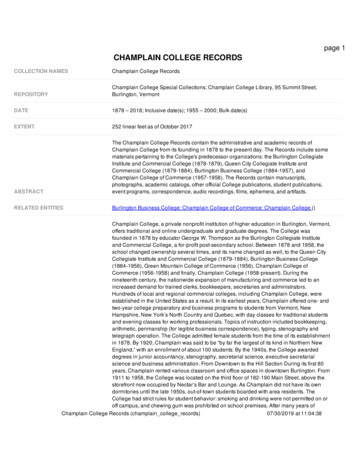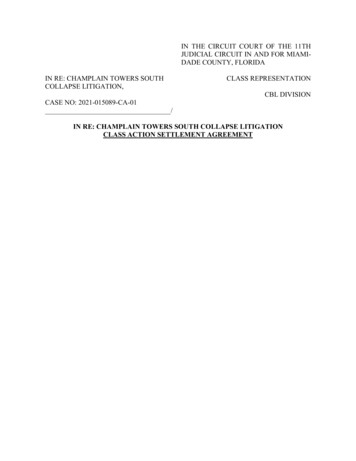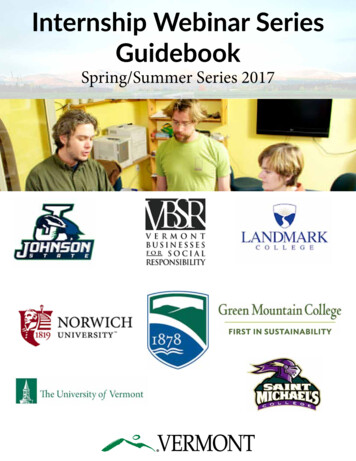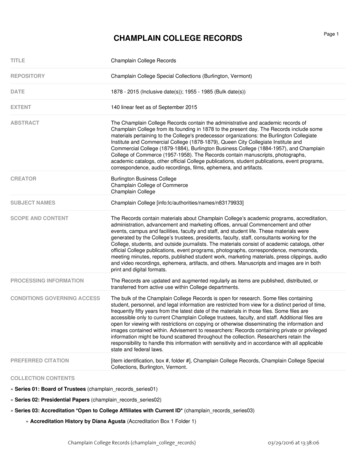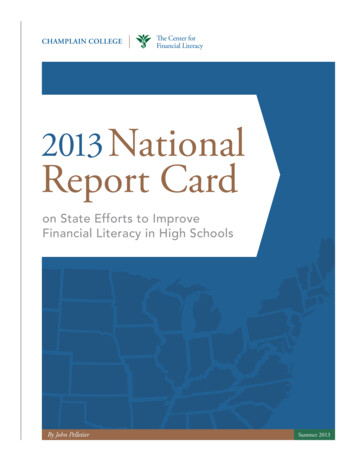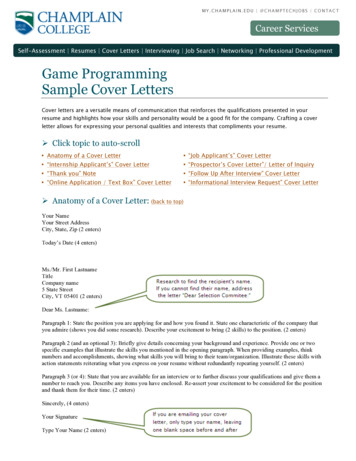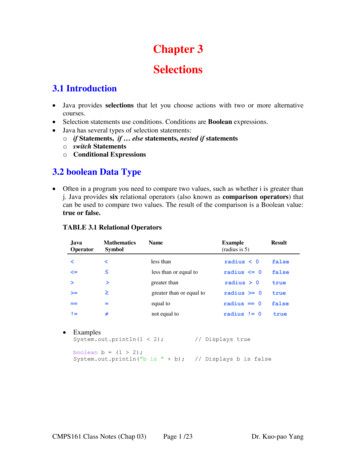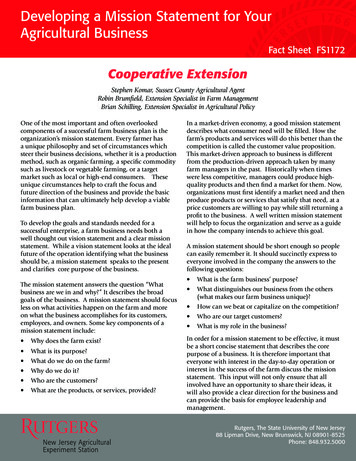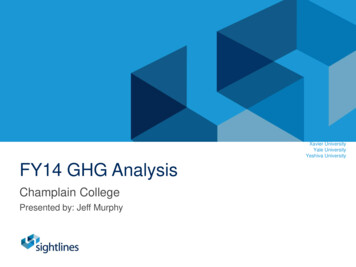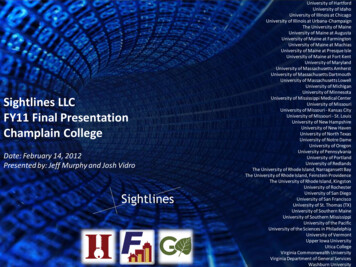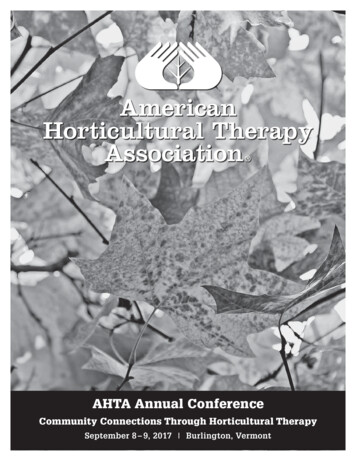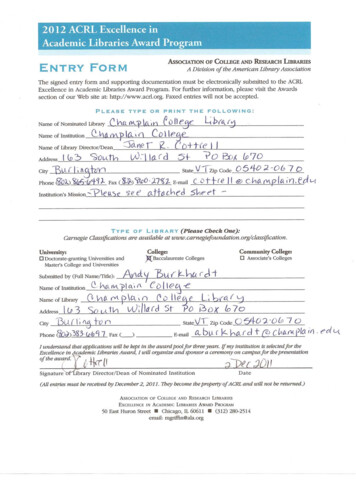
Transcription
Champlain College Mission StatementChamplain College endeavors to be a leader in educating today's students tobecome skilled practitioners, effective professionals and engaged globalcitizens. Champlain's agile and entrepreneurial approach to higher educationuniquely blends technology leadership, market savvy, innovation and fiscalresponsibility with a commitment to liberal learning, community involvementand "the human touch." This distinctive approach permeates the delivery ofrelevant, rigorous student-centered programs in business, arts, appliedtechnology and public service.
Champlain College LibraryApplication for ACRL Excellence in Academic LibrariesBy 2020 Champlain College will be the finest small, professionally and globallyfocused college in the United States. Champlain College Vision StatementChamplain College is an institution with high aspirations, a dynamic fast-paced school thatadapts rapidly to change. Academically, Champlain blends professional programs and liberaleducation with life skills such as service and financial sophistication, to educate the wholestudent. Academic programs are professionally-focused, with majors such as electronic gamedesign, environmental policy, digital forensics, graphic design, education, and business. Thecollege also offers master’s programs including mediation and applied conflict studies, businessadministration, emergent media, digital forensics, innovation and information technology, andhealthcare management. Current enrollment numbers about 2,000 traditional undergraduates,plus 400 graduate and 600 continuing education students, primarily part-time. Champlain wasfounded in 1878 and is located in Burlington, Vermont.Champlain integrates liberal learning with general education through its Core Curriculum, acommon curriculum required of all undergraduate students for all four years. It isinterdisciplinary, integrated, and inquirybased. In their final year, students round offtheir experience with a full-year capstonecourse integrating their professional majorand their general education studies.In order to realize its high aspirations andmeet its vision, Champlain has set fivestrategic goals: Achieving Distinctive AcademicExcellence Enriching Student Life Enhancing Financial Stability Exciting, Engaging & EmpoweringFaculty & Staff Fostering an Inclusive & Diverse CommunityMiller Information CommonsIn the Champlain College Library, we took these goals and the college’s mission intoconsideration during our own strategic planning process in the fall of 2009. Through a series ofhighly collaborative meetings, we created a mission statement for the library reflecting both themission of the college and our own unique approach to delivering library services:Champlain College Library endeavors to be a recognized leader in helping studentsbecome skilled, effective, responsible, life-long information users. We are agile,navigating quickly and effectively in the fast-changing environment of our profession,our College, and our higher education arena. We are entrepreneurial, securing anddeploying exemplary resources and services in innovative ways. We are thoughtful in ourapplication of new technologies, selecting and implementing the best available tools tosupport students and faculty in their information needs. We capitalize on the innovativedesign and purpose of Miller Information Commons. We maintain and promote it as anintellectual center on campus and a welcoming and supportive environment. We areknowledgeable and approachable, and are active in our profession locally, nationally,and internationally. This approach is the signature of both the physical and virtualLibrary, its resources, staff, and services, as we provide relevant, patron-centeredsupport to students, faculty, and staff.1
The library constantly strives to be an integral part of achieving the goals the college has setforth: whether by contributing to distinctive academic excellence through our innovativeinformation literacy program, enriching student life through events that blend learning and funlike Harry Potter’s World, or engaging and empowering faculty through an inclusive andrelationship-building collection development process. The following narrative illustrates howChamplain College Library and our team of library staff innovatively meet the needs of ourcommunity, develop exemplary and award winning programs that serve as models for otherlibraries, and build meaningful relationships will students, faculty and staff.Information Literacy and Lifelong LearningOne of the most noteworthy ways in which we contribute to the mission of the college andpromote distinctive academic excellence is through our innovative information literacy program.Technology and Information Literacy is one of the college-wide competencies in which allstudents are assessed and are expected to become proficient, and Champlain’s informationliteracy instruction program is unique in a number ofways: Our program is incremental and is embedded inChamplain’s Core curriculum. Like the Core, ourcurriculum is inquiry-based.Through this embedded program, librarians reachall students each semester during their first threeyears.Our common, sequential curriculum emphasizesways of knowing and asking rather than focusingon library-focused content.We evaluate student learning meaningfullythrough rubric-based assessments via an electronicportfolio system.Our ability to reach students in a coordinated, ongoingway enables the information literacy program to teachmore than just library skills. Rather, we are able to thinkbeyond which databases would be helpful for a certainassignment and deliver instruction that addressesStudents enjoying the terracechallenges in the dynamic information environment. Inresponse to the changing information landscape and inanticipation of the digital future, we deliver “Real Deal” information literacy instruction. Thistype of instruction reflects the college mission of helping students become skilled practitionersand effective professionals: students learn how to successfully meet information challenges notonly as college students, but as lifelong learners.While we continue to invite and encourage our students to use library resources, Real Dealinformation literacy differs from its traditional bibliographic or library instruction counterpart.It is: Inquiry-based, inviting students to share their perceptions and experiences ofinformation;Technology-savvy, because our students expect nothing less;Information-centric rather than library-centric, because we know that studentsencounter and use information in multiple environments; and,Grounded in the real world, both by being scholastically useful and by being relevantoutside the classroom.2
The information-centric nature of the this program provides students with the critical thinkingskills and habits of mind necessary in their personal and professional lives, not just in theiracademic lives. Our Real Deal program also challenges students’ perceptions of the librarian.Because our sessions are inquiry-based, librarians and students come together to explorequestions and learn from one another and about one another, both intellectually and personally.Our use of inquiry demonstrates that we areinterested in what they do and what they haveto say, giving them voice in an instructionsession. Students are often surprised thatlibrarians like Google or use Facebook. Theyappreciate being introduced to TED talks ontopics like “filter bubbles” or being asked touse cell phones in in the classroom forlearning exercises.- Tweet by a studentThis non-traditional approach breaks downstudent expectations of the library and librarians. It forces students to re-envision the librarianas a question-asking, technology-embracing, human search engine who is approachable andinterested in their work. We see increasing numbers of students at the Reference desk and findthat students are willing to use the library as a place of discovery and exploration rather thanmerely a quiet study space. Moreover, we are able to learn about our students’ pre-existingsearch habits and preferences. We use that information to improve our instruction and deliveryof services. Thus, we model responsiveness and, more importantly, the iterative approach tolearning.Information Literacy AssessmentLike all educators, we face a central question: we are teaching, but are students learning? And ifthey are, how can we demonstrate their skill attainment accurately?In studying the effectiveness of our instructional program, we rely on several sources ofinformation: evaluation of student work via e-portfolio; self-reports from students, includingresponses to supplemental questions in the Noel-Levitz survey; and anecdotal information.Clearly these sources are very different. This mix of quantitative and qualitative informationprovides alternative perspectives that help form a kind of "triangulation."Our information literacy outcomes assessment currently relies on rubric-based, courseembedded assessments in an Electronic Portfolio system. These assessments come directly fromfaculty evaluation of student work in general education “Core” courses. For each course in theCore curriculum, a team of faculty members create the common assignment and rubric that willbe used by faculty to assess student work in the ePortfolio system. Librarians collaborate withfaculty in developing these rubrics and then identify criteria from the rubrics that not onlyreflect course goals but also match outcomes in the information literacy competency. Rubricdevelopment and mapping are both done in consultation with the senior associate provost.Results for these specific criteria are extracted from the portfolio data and analyzed as evidenceof student information literacy outcomes.Evaluation of student work submitted in response to course assignments is the most directmeasure we have of student success. Specific aspects of student work are evaluated by facultymembers on a four-point scale: Does not meet expectations, Nearly meets expectations, Meetsexpectations, and Exceeds expectations. Evaluations of "Meets" or "Exceeds" are consideredevidence of having met the competency. To evaluate the overall success of the informationliteracy effort, we have set a preliminary target that 80% of Champlain students will meet thecompetency by graduation. Evidence to date shows that in the Class of 2011, 72% of studentsachieved competence, and in the Class of 2012, 77% of students have already met thecompetency. The figure below shows that the class of 2012 student cohort performed muchbetter by their third year than they did in their first year; sometimes the improvement wasdramatic in these two years.3
In addition to examining student work in order to evaluate how well students are meeting thecollege competency, we also use it to guide our instructional planning. In the very first semesterof the new Core curriculum, when the class of 2011 began, evaluation of student work showedclearly that students were not doing well at attribution and citation: only 56% were citing andattributing competently. We realized that we hadn't actually included any instruction on thetopic for this cohort. In subsequent years we added instruction -- and saw dramaticimprovement. Seeing student outcomes allows us to monitor results and adapt quickly andeasily, continually refining our instruction in light of student progress.Our approach to assessment serves as a bridge towards creating a culture of assessment betweenfaculty and administrators. The faculty’s adoption of a college-wide Technology andInformation Literacy Competency in 2005 reflects our faculty’s recognition that informationliteracy is a valuable part of a complete Champlain education. Faculty involvement in therevision of these competencies a few years later reflects more than just a cursory acceptance ofinformation literacy in higher education. Rather, the faculty’s adoption of our revised outcomesspeaks to their viewing us as collaborators and integral partners in student success. The library’sefforts to keep faculty abreast of our dynamic instruction and assessment programs is alsodemonstrated in our sharing of a curriculum map or matrix. This matrix illustrates when thetechnology and information literacy components are taught and assessed. The curriculum mapis another way in which the Champlain College information literacy program not onlydemonstrates its value to our students and faculty but also reflects our library’s commitment toaccountability and communication with our community.We have some indications that students also recognize our information literacy efforts. In 2011,Champlain College students identified Technology and Information Literacy as the mostimportant of seven College-wide competencies. In the Noel-Levitz Student Satisfaction survey,which the college administers regularly, students are asked to rate two aspects of each item: howimportant the item is to them, and how satisfied they are with the College on that item. Insupplemental questions about the college competencies included on the 2011 Noel-Levitzsurvey, students ranked the Technology and Information Literacy competency as the mostimportant college competency (the other competencies include written and oral communication,quantitative literacy, ethical reasoning, global appreciation, and critical/creative thinking).When students were asked to rate satisfaction with the College's contribution to theirdevelopment of these College-wide competencies, the Technology and Information Literacycompetency again ranked at the top. These results indicate that students are much more awareof the Technology and Information Literacy competency than we might have guessed, and thatthey are very interested in developing their skills in this area.4
We have shared our ideas about informationliteracy instruction and assessment regionally,nationally, and internationally (see Appendixfor a full listing of professional activities). InOctober, 2010, the Association for General andLiberal Studies (AGLS) honored ChamplainCollege with an Exemplary ProgramAward for our work in embedded informationliteracy assessment. This award recognizes- Tweet by a studentinstitutions that improve learning throughcollaborative efforts to gather results, use theresults to develop systematic learning improvement projects, and then verify thoseimprovements. In bestowing the award, AGLS wrote:The Champlain College application appealed to the judges because it describes aninformation literacy assessment program built on a collaborative relationshipbetween faculty and librarians described as 'a partnership for learning.' Thepartnership grew out of an effort to define information literacy outcomes and findassessment methods that faculty would support. The effort resulted in embeddedstudent assessments across the curriculum and support for an e-portfolioinitiative that allows for assessment of students’ skills developed through thecompletion of the four-year Core curriculum. Administrative support,professional development, and the commitment of both teaching librarians andfaculty have led to demonstrated improvement of information literacy skills.Teaching LibrariansSince the inception of the information literacy program, Champlain’s Teaching Librarians havemet regularly to prepare for the increasing role that our teaching would play at Champlain. Thisgroup’s initial anxiety around changes to Champlain’s instruction program, embeddedassessment, and the need for all librarians to teach regularly was palpable. However, four yearslater, Champlain’s Teaching Librarians group is an enthusiastic, dedicated, and skilled team ofteachers who value collaboration, cultivate a supportive environment, and aren’t afraid to takerisks or innovate in the classroom.Our success in creating an effective team of teachers comes from the diversity of our group andour unique approach to teamwork. Champlain’s Teaching Librarians group, informally referredto as "the TLs," includes librarians responsible for technical services, interlibrary loan, emergingtechnologies, reference, and collection development. These different lenses into librarianshipcontribute to the success of our group. Our instructional design process is collaborative andteam-based: each librarian participates in the creation of lessons and activities, even for sessionsthey will not teach. Together, we assess the skills and habits of mind appropriate to students’development. We consider the learning styles students have encountered in the curriculum, andpush ourselves to create lessons that invite all types of learners into the session. We aim todesign activities that invite our students to learn.Moreover, the Teaching Librarians have focused their energy on more than just preparing forinstruction. The group has formed a learning community around information literacy andpedagogy. The supportive and collaborative environment of the TLs has enabled each librarianto develop his or her teaching identity. These identities are cultivated through individual andgroup exercises, discussion, retreats, and community reading. But most importantly, they arecultivated by a shared respect for our individual strengths, weaknesses, areas of expertise, andstyles. We support one another to teach in our own way. For example, one of the TeachingLibrarians led the group through the creation of our individual teaching philosophies, based onChar Booth’s Reflective Teaching, Effective Learning, our Summer must-read. Below, eachTeaching Librarian is pictured with an articulation of his or her own teaching philosophy:5
“As a teaching librarian, I want to make information, tools, andstrategies accessible and meaningful to my students in amemorable and engaging way. I want students to feel lessoverwhelmed and more in control when they leave myclassroom.”Hanna Bachrach“As a teacher, I want to get students excited about information,how we use it and how it affects us. I want them to take mylesson and run with it. Most of all, I want to inspire curiosity in afun, inclusive environment.”Andy Burkhardt“For me, teaching is an adventure. I want students to know thatI am on this adventure with them. In the classroom, I approachlearning together with curiosity, energy, and enthusiasm.Ultimately, I am not here to judge them or grade them—just tohelp them.”Sarah Cohen“My teaching philosophy is all about striving to become a betterteacher. A big part of that involves incorporating practices thatwill build a bridge between students and the Library, and showthem that I’m interested in them as individuals as well as in theiracademic success.”Michele MeliaPaula OlsenBrenda Racht“When I talk to first-year students about doing research, I recallmy own experience as an undergraduate studying the Americanpoet Robert Frost. I talk about using books and journals,listening to the man himself on vinyl, a perhaps fortunatechance for an interview with someone who knew him, and lastly,a trip to Ripton, Vermont and a quiet walk around his cabin onproperty located there. It doesn’t matter if the books andjournals are in print or online. What I always hope for is thatthey will catch the magic that can happen when you look atsomething or someone inside out. I want students to becomepassionate enthusiasts of discovery.”“When I am in the classroom I try to keep a positive attitude. Itry to keep things simple. I try to use humor whenever possible.When the lesson is over I hope that I have learned somethingand that students have something to take with them that theycan reflect upon. Not only do I want to teach, but I want to get toknow and relate to these students, even if it is on a very smalllevel.”6
These librarians now identify themselves as a group of teachers who believe in the mission of theprogram, execute our program effectively, and are committed to its success by participating inits development and change.A Unique Collection that Builds RelationshipsWhen our library building was built in 1998, it was designed to hold a limited number of printmaterials, predicting (correctly) that electronic materials would only become more prevalentand more significant to the academic lives of our students and faculty. Today, our e-bookcollection is nearly twice the size of our print book collection, with e-book holdings at 79,851 andprint holdings at 46,478. Our distance students appreciate the depth and breadth of the libraryresources available to them and our on-campus students appreciate the easy access to many ofthe library’s resources. Because our print collection is small, we are able to tailor it completely tothe needs and interests of our users. Additionally, a reciprocal borrowing agreement with theUniversity of Vermont allows students, faculty, and staff access to a university research library.We think of our collection as a mirror of our community and we build and maintain itaccordingly: with close and constant communication with faculty and other communitymembers. Our collection, like Champlain College, is professionally focused, supporting studentsand faculty in their work in disciplines like game design, international business, environmentalpolicy, digital forensics, and social work. Because our print collection is small, we are able tochoose each item we add to it with care, purpose, and clarity about exactly how it will supportthe college curriculum.Nearly all of our collection development decisionsare made in close communication with faculty andthis communication is a two-way street; thoughfaculty members regularly come to us withsuggestions for new materials, we constantly go tothem with book reviews relevant to their areas ofinterest, questions about needs for a particularclass, or prospective databases on which we’d liketheir input. These conversations happen duringinformal discussions while walking across campus- Tweet by a faculty memberor grabbing a cup of coffee in the cafeteria asoften as they happen in formal meetings, via email, or in phone conversations.Additionally, the Library Director and the Scholarly Resource and Academic Outreach Librarianboth serve on the college’s curriculum committee, where new courses and programs areproposed, critiqued, and approved. As part of the approval process, each proposed course orprogram is reviewed by the library; this is our opportunity to explore how the library’s collectioncan support each proposed curricular change. Being part of this process not only enables us tomaintain an ongoing awareness of curricular changes, but also allows us to present facultymembers with a comprehensive assessment of the library’s relevant resources for each newcourse or program and to build the collection alongsidethe curriculum, with faculty’s support. Faculty members“Our library is very responsive toare grateful for our role in this process, as they oftenfaculty needs. Librarians workdiscover new library resources and are encouraged towith faculty to support ourmake suggestions of new materials.courses and our students’research, both in terms ofOne of the most important ways we keep our collectionvibrant is through enthusiastic and regular deselection.acquisitions and in terms ofAs with all aspects of collection management, facultyfacilitating students in theirmembers are heavily involved in weeding; in fact, weresearch projects.”- Faculty memberweed a given area of the book collection only incollaboration with at least one faculty member from the7
related department. For example, when we recently weeded our legal studies collection, threefaculty members spent an entire morning in the stacks with one of our librarians, consideringeach book for its relevance to their students. Since many of Champlain’s academic programs areinterdisciplinary in nature, we are always aware, when weeding with faculty from one discipline,of the potential relevance of materials to a related academic area. Without exception, facultymembers leave these weeding sessions with a renewed enthusiasm for collaboration in thebuilding and maintaining of our collection. They often leave with a tall stack of books to borrow,too. As librarians weed alongside faculty members, we take notes on the conversation, recordingareas that are mentioned as targets for future growth as well as areas that are particularly wellrepresented.It is this constant exchange between librarians and faculty that keeps our collection vibrant,current, and responsive to the needs of our community. In any given year, faculty membersrecommend about 50% of books purchased for the collection. Recent informal feedback aboutthe collection itself as well as the processes we have implemented to collaborate with facultymembers is extremely positive. One faculty member’s description of the improvement since2002 highlights the stark contrast between then and now, evidence of the success of ourintensive outreach efforts in the service of the collection:We know, for example, what those shelves used to look like, just as we remembercringing with embarrassment back then to see shelves and shelves of books thatdid not belong in any college library. Those days are gone now, for which theentire community is thankful. Dramatic changes of the kind we have seen in ourlibrary do not happen by themselves. Anyone who thinks our library does nothave books is a person living in the ever more distant past. We can all be proud ofour library now.–Champlain faculty memberThe cumulative effect of these efforts is a noticeable improvement in the print collection asevidenced by positive remarks from faculty members about the holdings as well as risingcirculation rates for the print collection. In the past five years, circulation of books byundergraduates has risen a full 65%. Not surprisingly, Champlain students express significantlyhigher student satisfaction with library resources and services than our national peers.1Since we have a living, changing, tailored collection,we are committed to and creative about making itvisible and accessible to our community. One waythat we do this is by leaving the covers on all of ourprint books, so that they are much more intriguingand interesting to browse than the averageacademic collection. To give our carefully chosennew books full exposure to the community, we putup a new books display each month just inside thelibrary’s entrance; this display is heavily browsed byboth students and faculty and after a few days, agood number of the new books have been checkedout. When this display goes up, an email is sent toFaculty members enjoying a “new books” receptionthe community, describing our collection’s mostrecent arrivals and highlighting a few new titles;the full list of new books is available on our website each month. In addition to highlighting ournew books, we host faculty receptions in the library for individual academic divisions eachsemester, inviting the faculty of a given division (business, for example) to browse our print andelectronic collections while taking a break from their day to eat a cupcake, have a cup of punch,and socialize with the librarians. These receptions give us yet another opportunity to get1Noel-Levitz Student Satisfaction Inventory, 2008 and 2011 results, Champlain College compared to national four-yearprivate institutions.8
feedback from faculty on our resources while simultaneously giving faculty the chance to stay intouch with the collection.Finally, we promote our collection in an ongoing wayby creating fun, one-inch buttons showing images(color-photocopied, of course) from our books. Wealways have a basket full of these buttons at thereference desk and they have become extremelypopular on campus. It common to find a small groupof students clustered around the basket, looking for afavorite button. Recently, when a student learned thatall the buttons were created from images from booksin the library collection, he exclaimed “No wonderthey’re so cool!”Students choosing a button at the deskFostering a Sense of Campus CommunityOne of the library’s most important goals is to foster a sense of community on our campus. Weunderstand that the library can be a place to gather, especially around intellectual and academicpursuits. We also understand that librarians are important members of the community and needto be involved both in the library as well as around campus in order to create meaningful andproductive relationships with students, faculty, and staff.In the Miller Information Commons, we succeed in keeping the building buzzing with activityand events in order to show that the library is not only a place for quiet reflection, but also aplace for fun and engagement with the community around both scholarly as well as moreinformal pursuits. An illustrative example of one of these events is our Meaningful Book Series.Every semester, we ask a faculty or staff member of the College to select several books that havea special meaning to them. Then we host an event (often with maple cookies and Vermont applecider) where the person discusses their books and what makes them meaningful. These eventsoften draw faculty and staff from widely varied parts of the college, and the format and structureof the event allows the community more intimate insight into one of its members through thelens of literacy and what they read.A major project that built community aroundacademic pursuits was the exhibit HarryPotter’s World: Renaissance Science, Magic,and Medicine sponsored by the NationalLibrary of Medicine and the National Instituteof Health, hosted by the library in the fall of2010. This exhibit explored Harry Potter’sworld with its roots in Renaissance science andexamined important ethical topics such as thedesire for knowledge, the effects of prejudice,and the responsibility that comes with power.The terms of serving as a host site for theexhibit required only a handful of events,
Champlain College Library Application for ACRL Excellence in Academic Libraries By 2020 Champlain College will be the finest small, professionally and globally focused college in the United States. Champlain College Vision Statement Champlain College is an institution with high aspirations, a dynamic fast-paced school that adapts rapidly to .
